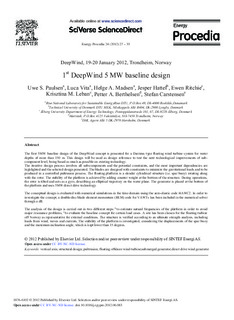1st DeepWind 5 MW Baseline design
Paulsen, Uwe S.; Vita, Luca; Madsen, Helge A.; Hattel, Jesper; Ritchie, Ewen; Leban, Krisztina; Berthelsen, Petter Andreas; Carstensen, Stefan
Journal article, Peer reviewed
Published version
Permanent lenke
http://hdl.handle.net/11250/2483909Utgivelsesdato
2012Metadata
Vis full innførselSamlinger
- Publikasjoner fra CRIStin - SINTEF Ocean [1387]
- SINTEF Ocean [1461]
Sammendrag
The first 5MW baseline design of the DeepWind concept is presented for a Darrieus type floating wind turbine system for water depths of more than 150 m. This design will be used as design reference to test the next technological improvements of sub-component level, being based as much as possible on existing technology.
The iterative design process involves all sub-components and the potential constraints, and the most important dependencies are highlighted and the selected design presented. The blades are designed with constraints to minimize the gravitational loads and to be produced in a controlled pultrusion process. The floating platform is a slender cylindrical structure (i.e. spar buoy) rotating along with the rotor. The stability of the platform is achieved by adding counter weight at the bottom of the structure. During operations, the rotor is tilted and acts as a gyro, describing an elliptical trajectory on the water plane. The generator is placed at the bottom of the platform and uses 5MW direct drive technology.
The conceptual design is evaluated with numerical simulations in the time domain using the aero-elastic code HAWC2. In order to investigate the concept, a double-disc blade element momentum (BEM) code for VAWTs has been included in the numerical solver through a dll.
The analysis of the design is carried out in two different steps:1) to estimate natural frequencies of the platform in order to avoid major resonance problems, 2)to evaluate the baseline concept for certain load cases. A site has been chosen for the floating turbine off Norway as representative for external conditions. The structure is verified according to an ultimate strength analysis, including loads from wind, waves and currents. The stability of the platform is investigated, considering the displacements of the spar buoy and the maximum inclination angle, which is kept lower than 15 degrees.

